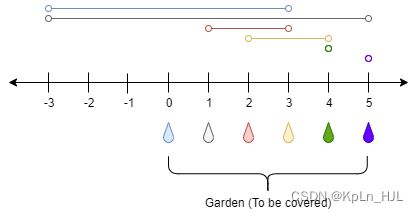leetcode - 1326. Minimum Number of Taps to Open to Water a Garden
Description
There is a one-dimensional garden on the x-axis. The garden starts at the point 0 and ends at the point n. (i.e The length of the garden is n).
There are n + 1 taps located at points [0, 1, …, n] in the garden.
Given an integer n and an integer array ranges of length n + 1 where ranges[i] (0-indexed) means the i-th tap can water the area [i - ranges[i], i + ranges[i]] if it was open.
Return the minimum number of taps that should be open to water the whole garden, If the garden cannot be watered return -1.
Input: n = 5, ranges = [3,4,1,1,0,0]
Output: 1
Explanation: The tap at point 0 can cover the interval [-3,3]
The tap at point 1 can cover the interval [-3,5]
The tap at point 2 can cover the interval [1,3]
The tap at point 3 can cover the interval [2,4]
The tap at point 4 can cover the interval [4,4]
The tap at point 5 can cover the interval [5,5]
Opening Only the second tap will water the whole garden [0,5]
Example 2:
Input: n = 3, ranges = [0,0,0,0]
Output: -1
Explanation: Even if you activate all the four taps you cannot water the whole garden.
Constraints:
1 <= n <= 10^4
ranges.length == n + 1
0 <= ranges[i] <= 100
Solution
For example2, we need to water the interval between 1 and 2.
Draw the range that each water tap could cover, like example1 does, then this problem is converted into 45. 跳跃游戏 II.
Build jump list, jump[i - span] = i + span, and also jump[i] = i + span.
Then use greedy to solve jump game.
Time complexity: o ( n ) o(n) o(n)
Space complexity: o ( 1 ) o(1) o(1)
Code
class Solution:
def minTaps(self, n: int, ranges: List[int]) -> int:
if not ranges:
return -1
range_array = list(range(len(ranges)))
for i, span in enumerate(ranges):
range_array[i] = max(range_array[i], i + span)
update_index = max(0, i - span)
range_array[update_index] = max(range_array[update_index], i + span)
cur_most = -1
next_most = range_array[0]
res = 0
for i, jump_step in enumerate(range_array):
if i > next_most:
res = -1
break
if i > cur_most:
res += 1
cur_most = next_most
next_most = max(next_most, jump_step)
return res
